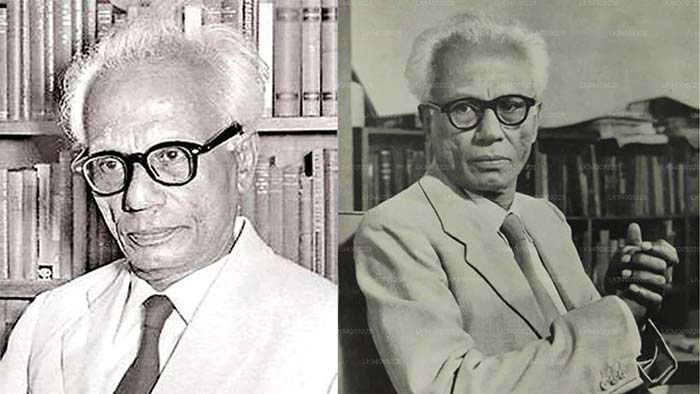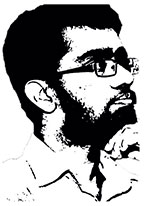Features
The Other Martin Wickramasinghe

By Uditha Devapriya
For most of us, Martin Wickramasinghe tends to evoke nostalgic visions of childhoods spent in villages, of travels down south, of Joe Abeywickrema reciting pansil to his inquisitive children and being left speechless by their interest in one particular silaya, which I shall not mention here, but which all those who have read the book and watched the film will know. That was the gentle, kindly Wickramasinghe, the man who turned his village into a universe of its own in much the same way Mark Twain did with Mississippi.
It was later, much later, that we came to confront the other Martin Wickramasinghe: the man who read widely and wrote prolifically on anthropology and biology, whose reading of Buddhism put him at odds with the many revivalist movements of his time, whose belief in cultural synthesis and evolution pitted him against both Westernised elites and nationalist anti-Westerners. His critique of narrow nationalism – as deep as his critique of uncritical Westernisation – went a long way in showing us that these were two sides of the same coin. The one simply reflected the other, and was amplified in the other.
Wickramasinghe tends to be seen and read in a particular light, and for better or worse his wider scholarly forays have been neglected. Though he is not identified with the type of Sinhala Buddhist nationalism that the likes of Jathika Chintanaya propagate at present, he is nevertheless identified as the great Sinhala and Buddhist culturalist, someone who revived pride in that culture. In itself, there is nothing wrong with such a reading: one can make the same case for other artistic figures, like Amaradeva, Chitrasena, Manjusri, or Lester James Peries. But if we stick to such a reading, we tend to neglect if not lay aside the complexity of the man, the mind, and his writings.
Perhaps the most essential point about the other Wickramasinghe was his study of and passionate advocacy of anthropology. By the early 20th century anthropology was fast losing its Orientalist character. Malinowski’s work in the Trobriand Islands, and at the London School of Economics, freed the subject from its colonialist roots. While Africa and Asia had once been seen as primitive societies whose function it was – or rather seemed to be – to reinforce the superiority of Western civilisation, now they were being studied on the basis of their internal structures, hierarchies, and functions.
When Wickramasinghe – who I think we can call Sri Lanka’s first anthropologist – began writing on the subject and adopting anthropological frameworks in his studies of Sinhala culture, the Ceylonese academic establishment did not really see it fit to teach, or include, anthropology in our universities. The Indian scholar Kewal Motwani, in a series of letters, criticised none less than Ivor Jennings for failing to include the subject at the University of Ceylon. Wickramasinghe reiterated his critique. In his view, the culture of intolerance that swept the country during the 1950s – particularly over the language issue – could have been avoided had there been serious efforts to promote the subject.
For someone who lacked a university education, even a school education, Wickramasinghe was well informed on these subjects. His writings spanned the whole gamut of the social sciences, of history and art history, of religious and cultural studies. Many of his observations gained mainstream acceptance. Some did not.
Adopting the American anthropologist Ruth Benedict’s framework, for instance, he once depicted Sinhala society, with its emphasis on self-discipline, as Apollonian, and Hindu society, with its culture of religious ecstasy, as Dionysian. What is important is not that such claims were criticised, but that they were made at a time when it had become fashionable among mainstream academia to look down on local culture.
In studying the local culture, however, Wickramasinghe did not commit the opposite error of romanticising it. This is his point of departure from the nationalist-revivalist camp, the most articulate voices of which can be found today in Jathika Chintanaya. His critique of such ideologies runs into several essays, and to reproduce or summarise them all here would be quite tedious. But several themes run through them all. Three of them, in particular, merit our attention, since they shed much light on his thinking.
The first is his view of Buddhism as rationalist and compatible with science. It was no coincidence that he adopted the penname Hethu Vaadi or “Rationalist” in his Silumina column in the 1910s. Though nationalist ideologues dismiss Wickramasinghe’s knowledge of science as self-taught and haphazard, as lacking depth, it was the way he linked the hard sciences, biology in particular, to the social sciences, anthropology in particular, in the context of Sinhala culture that made him stand out. I would argue that his lack of university training was paradoxically what enabled him to make this contribution.
The second is the very important point that Wickramasinghe did not rationalise Buddhism in the way his critics assume he did. In his reading, Buddhism as a religion was eminently capable of adapting to different cultures and contexts. This is the Jathika Chintantanaya’s view of religion as well: that, at the end of the day, it is defined by the cultural universe it occupies. Indeed, I think Wickramasinghe was as critical as they were of those who tried to divorce religion from culture, from society. Buddhism in Sri Lanka, in his view, could not be separated from Sinhala culture, including folk society, literature, and of course art.
The third is the suggestion, the implication, that nationalist-revivalists themselves borrowed from the ideological framework they try to undermine. The best explanation for this, in my view, is that most nationalist ideologues here emerged from the very urban-suburban academic background they later tried to distance themselves from.
I would contend that this dualism inhibited them in the longer term. These ideologues were caught between two worlds: the rational and liberal arts tradition they had been born to, versus the romantic utopian universe they had retreated to. That led them to share much of the same ideology of the Westernised elites they were pitted against.
To quote Wickramasinghe himself on this,
“Nationalists as well as denationalised educated men laugh at and ridicule the dress of the present-day Sinhalese villager-coat and clot or coat and sarong. But is not this dress of theirs an innovation, however crude, and a proof of the elasticity of their culture and the plasticity of their mind? Educated people should make conscious attempts to evolve a national dress basing it on the villager’s unconscious innovations.”
One discerns an almost utopian view of the Sinhalese villager in this passage. But in locating the matrix of Sinhala Buddhist culture in the village, Martin Wickramasinghe undermined the arguments of nationalist-revivalists, most of whom after all came from petty bourgeois milieus, who were interested in social advancement and based their whole campaign on the goal of undermining the Anglicised elite. In trying to undermine that elite, they tended to ignore the essentially synthetic character of Sinhala culture. This, Wickramasinghe suggests, blinded them to certain aspects of that culture, like folk society.
My friend Dhanuka Bandara describes Wickramasinghe, along with Ananda Coomaraswamy, as a proponent of “agrarian utopianism.” I would be inclined to agree, but would add that unlike Coomaraswamy, Wickramasinghe did not wish to return to the past or revive it in its entirety. In this I think the man disagreed with Sinhala nationalists, though he understood, in a way their critics do not, where the nationalists were coming from. At the end of the day, that may be his greatest achievement and contribution: what made him the superior of the many nationalist ideologues and groupings we see today.
Martin Wickramasinghe’s whole point was that culture was never sterile: that it evolved, changed, and ruptured, from within and without. He championed, not the glories of some imagined past, but the realities of a material, tangible present.
Critics have contended that his Koggala trilogy reveals an almost passionate attachment to the Sinhala village and to all that the village represents. There is nothing wrong with such a reading. But Wickramasinghe knew, in a way his nationalist critics – even supporters – did not, that the village could not stand for long. He likened our attempts to reclaim the past to a search for kalunika: it simply could not be done. It is this Martin Wickramasinghe that we have yet to explore and assess: unknown, though hardly unknowable.
Uditha Devapriya is a writer, researcher, and analyst based in Sri Lanka who contributes to a number of publications on topics such as history, art and culture, politics, and foreign policy. He can be reached at udakdev1@gmail.com.
